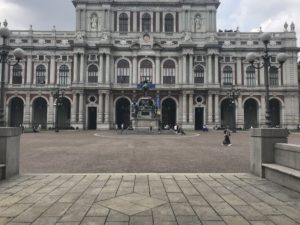By Dr. Andrés R. Amado, PhD
Future musicians and scholars may further analyze the stylistic and technical features of Fantasia Suite, enriching the interpretation of Larsen’s work and its appeal. However, to better assess the significance of the suite and its contribution to the piano literature requires a deeper engagement with its historical context. Elements of style must be interpreted in relation to cultural developments that affect not only the composer but also performers of his music and the audiences they engage with. This contextualization of Fantasia Suite is based not only on conversations with the composer, but also on emerging narratives in contemporary historiography of musical developments of the twentieth and twenty-first centuries.
 Larsen does not claim a commitment to any particular school of composition, artistic movement, or trend. He undertook composition purely motivated by his artistic inclinations. Nevertheless, his upbringing in California, his career as a concert pianist in Europe, his studies of composition within and without institutional settings, his engagement with the film industry, his discovery of Latin music, as well as the in- tellectual and artistic currents moving through the Western industrialized world at the time he composed, are all factors that have helped shape the inception and reception of his music.
Larsen does not claim a commitment to any particular school of composition, artistic movement, or trend. He undertook composition purely motivated by his artistic inclinations. Nevertheless, his upbringing in California, his career as a concert pianist in Europe, his studies of composition within and without institutional settings, his engagement with the film industry, his discovery of Latin music, as well as the in- tellectual and artistic currents moving through the Western industrialized world at the time he composed, are all factors that have helped shape the inception and reception of his music.
Born in San Francisco in 1955, Carter Larsen was raised in an environment where a vibrant counterculture was transforming society in the United States and the world. The 1960s and 1970s saw calls from various groups for social change. A hippie subculture also emerged at that time and explored alternative sensorial experiences, and, by extension, alternative modes of consciousness. Not coincidentally, the turbulent environment of protest, contestation, and experimentation in which these social movements emerged also nurtured artistic movements that challenged the aesthetics upheld by traditional institutions like conservatories, museums, and universities.
Minimalism, for instance, was one movement that acquired a strong presence on the West Coast. It rejected the models of its predecessors by turning to simpler methods of composition, and in this regard revealed the generational and ideological tensions that existed in the United States in the 1960s and 70s. Such tensions affected the artistic trajectories of many musicians and composers, even those not pursuing the minimalist path, because they all had to confront an increasingly fragmented musical environment. While such fragmentation was apparent through Larsen’s formative years in California, it had been de- veloping over the course of many decades.
By the 1960s, two modes of thinking prevailed in the so-called “art” or “classical” music milieu of the twentieth century, particularly in the United States. One, pursued by Schoenberg, Stravinsky, and others, saw music as evolving through history. Although not always in agreement among themselves, these composers believed that their mission was to take further steps along that evolutionary path, leaving be- hind the past while building upon it.
Another perspective sought to disrupt traditional compositional approaches as an act of rebellion against a status quo that seemed to stifle creativity and artistry. Such attitudes were aligned and sometimes even informed by the various social movements of the twentieth century. Both evolutionist and disruptivist positions charted artistic paths, but did not dictate stylistic developments. Indeed, composers within each group approached their work differently and some were even at odds with each other.
Ironically, despite the differences between them and within these trends, both groups headed in a similar direction in which “serious” or “art” music continued to drift away from the music that most people enjoyed and consumed on a daily basis. In the larger cultural context of the United States, The Beatles were a more common household name than most composers of art music. Carter Larsen began his artistic career in this splintered musical environment and had to confront these questions.
Having studied piano since the age of six, Larsen first pursued a career as a concert pianist. He was recognized in Europe as an interpreter of the Romantic repertoire, playing works by Chopin, Liszt, Saint-Saëns, Grieg, Rachmaninoff and others. Given the long tradition of piano music in Europe, audiences and critics were not prone to welcoming just any outsider as a legitimate concert artist. The fact that Larsen, a Californian, had an active career in Europe for close to two decades speaks highly not only of his mastery of the piano literature, but also of his knowledge of the European culture that nurtured it.
Larsen’s pianistic lineage derives from a myriad of prominent European teachers. For instance, he studied with Ruth Nye, a student of Claudio Arrau, who had studied with Martin Krause, a pupil of Liszt. Larsen was also taught by Peter Feuchtwanger, a former student of Edwin Fischer, who also studied with Liszt’s protege Martin Krause. Those are but two examples. However, Larsen also had many noteworthy teachers who similarly trace their artistic lineages to the best known classical and Romantic artists of Europe. Needless to say, Larsen was therefore more intensely drilled in the classical and Romantic traditions than most pianists from the United States can boast.
This experience gave Larsen options. On the one hand, he developed a deeper appreciation for the repertoire that the evolutionist and disruptive composers were seeking to leave behind. Larsen never felt the need to definitively break away from the canon of classical composers. To this day, classical notions of form, style, and pianistic technique continue to permeate his approach to composition.
Meanwhile, Larsen remained as interested in composing as he had ever been. In his youth he was the youngest composition student at the Juilliard summer home in Aspen, Colorado, and studied composition at the San Francisco Conservatory with John Adams. While in Europe, Hollywood offered an outlet for his compositional creativity, and he began writing music for films while still performing the music of the high Romantics. He thus became part of two creative environments without exclusively belonging to either, but also without intersecting them. His original works remained hidden from European audiences, while his performing career was overlooked by the film industry in the United States.
His music achieved greater recognition in the 1990s, when he returned to his country of origin. He founded a publishing company in 1995, and a recording company in 1999. In his recordings as well as his live performances, Larsen began crossing the divide between his roles as interpreter and composer. His record company produced albums of classical music, film soundtracks, and Larsen’s original compositions.
Given this career trajectory, Larsen does not feel he belongs to any particular school of composition, especially not to those developing in the United States. He was more influenced by popular music and the film industry, as well as by the Romantic music he performed. Ironically, by adopting seemingly conservative and accessible musical idioms, Larsen was rebelling against evolutionary and disruptive musical trends. His music pushes against academic composers who viewed tonality as obsolete; and at the same time he rebelled against composers who were also rebelling against the academy, such as minimalists.
In this regard, while working independently and creating his own musical style, Larsen has no qualms about maintaining tonal organization or incorporating vernacular idioms such as folk tunes into his work. Leonard Bernstein also rejected divisions between classical and popular music by unapologetically blending classical elements with Broadway music and jazz. Similarly, Philip Glass shows great versatility as a composer of film scores and of classical genres such as operas and symphonies. A comparison between Larsen and Glass may be apt, because, even when they embrace different aesthetics, both composers exhibit an entrepreneurial spirit that has allowed them to thrive outside the structures that legitimized serious music (universities, conservatories, etc.).
Since these composers developed different styles, it would be incorrect to claim they belong to a particular school of composition or artistic movement. However, they do share traits in the ways in which they negotiate and challenge boundaries between established musical traditions. They demonstrate that even when academic and artistic discourses sometimes privilege composers who break from particular trends in dramatic ways, others continue to innovate within existing forms.
The term “Neo-Romantic” best describes Larsen because of his particular contribution to the literature of the piano, the Romantic instrument par excellence. Larsen engages with the piano more intensely than other composers of his generation. His disposition towards engaging popular and film music also evokes Romantic composers who similarly embraced the popular genres and tunes of their day. Think of Chopin’s waltzes, polonaises, and mazurkas, which derived from folk and salon dances. Think of Liszt improvising on famous opera arias at the explicit request of his audiences.
Even the later Romantics did not resist incorporating music that people liked to sing and dance to in their everyday lives. Brahms wrote Hungarian dances, and Mahler used “Frère Jacques” in a symphony. I believe the term Neo-Romantic is also appropriate because Larsen pursues new approaches. Elements that distinguish his music from that of 19th-century Romantics include Larsen’s revolutionary pedaling effects, the illusion of flexibility and improvisation created through highly specific tempo markings, and his unique use of juxtaposition rather than motivic development as a structuring device, something I previously described as “collage.”
Given the range of technical challenges it contains, its diverse influences, its lyrical expressiveness, and its accessibility to audiences of various musical backgrounds, Fantasia Suite continues to attract pianists and audiences of diverse backgrounds and thus will continue to be performed in years to come. Present and future musicologists, theorists, and performers characterizing Larsen’s output should not overlook the prefix Neo and its implications. Consequently, they should approach Larsen’s collection mindful of the differences as well as the continuities that it represents as a work developed over the course of forty years and thus transitioning between the twentieth and twenty-first centuries.
By Dr. Andrés R. Amado, PhD